Now that we’ve learned 3 words of Spanish, it’s time to put it into practice! We’re busy during the week, but on weekends we’re free to explore the Quito area! A whole team from our school set off in the direction of Baños. The merry band is made up of several Germans, a Belgian, a Dutchwoman, a Brazilian, an Ecuadorian, and of course your two favorite Swiss! Here’s the story of our 2 days in Baños, Ecuador! 😉
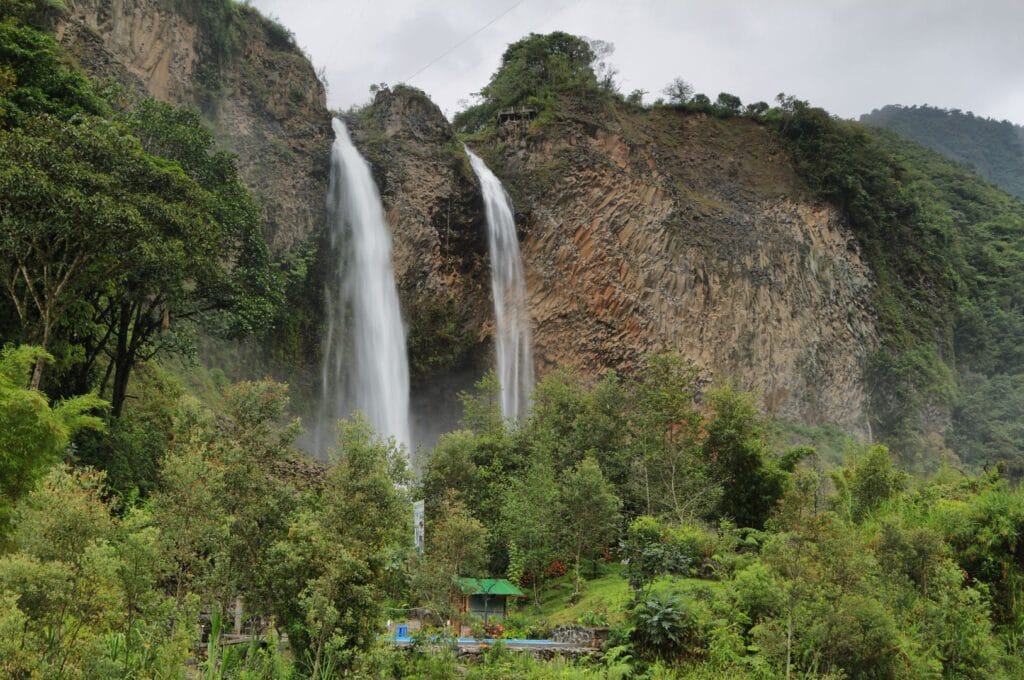
We took this trip in 2014, but the article was completely revised and updated in October 2023. If you see any price changes or have additional information that might be relevant, please feel free to leave us a comment!
Introducing Baños: hot springs, volcanoes, and adventure sports in Ecuador
So when a Spanish beginner like me hears baños, she understands WC. But the town wasn’t named after the bathroom! But its name also means baths, and that’s what makes it so special, although we’ll come back to that later.
Baños (from its full name Baños de Agua Santa) is a charming little town in Ecuador, located 3 h 30 south of Quito and perched at an altitude of 1815 m, just below the active volcano known as Tungurahua (over 5000 m above sea level, after all!).
Baños is probably one of Ecuador‘s main tourist attractions, for 3 reasons. Firstly, this region in the Andes is absolutely stunning! Just imagine for a few seconds a small village perched at the foot of a volcano, at the mouth of a gigantic valley over 20 km long, where one waterfall follows another (la ruta de las cascadas)! But it’s also one of Ecuador’s must-see places for thrill-seeking sports… Finally, it’s one of the preferred gateways for travelers to the Amazon. In short, there’s no shortage of things to do in Baños!
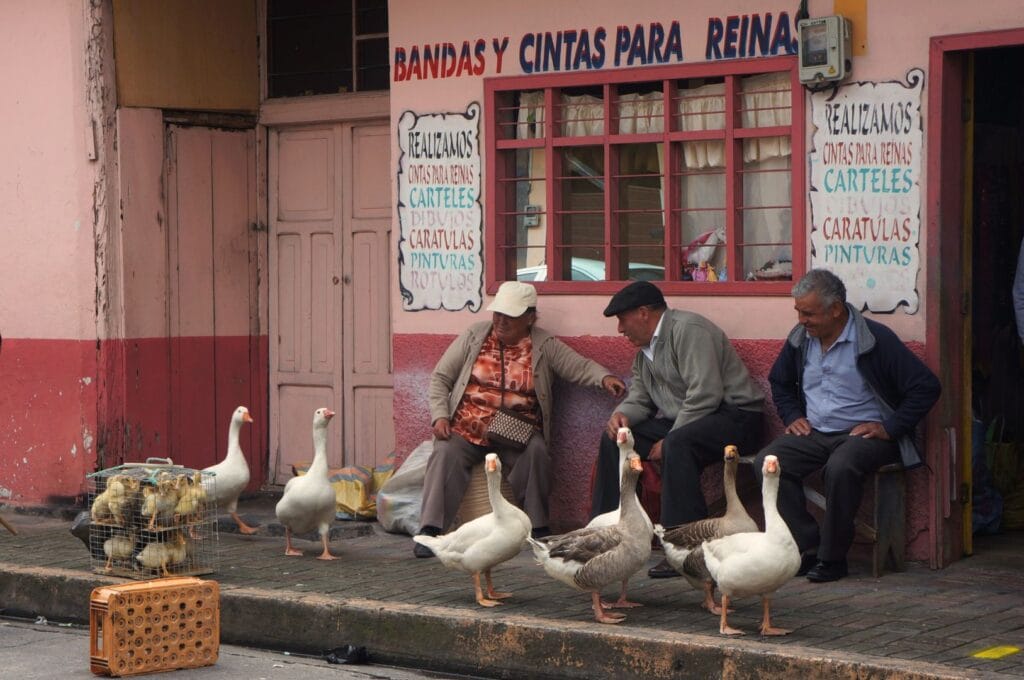
Getting to Baños
We set off from Quito to get to Baños, and it was a good trip by bus. It takes about 3 hours and 30 minutes to get there from the Quitumbe terminal, in the south of the city. Several buses leave throughout the day and prices are reasonable (6-7 dollars).
From Guayaquil, in western Ecuador, it’s a 6-hour trip to Baños. Tickets are around 13 dollars and can be purchased here or here.
Finally, from Cuenca in the south of the country, 2 buses run the route every day for 13 dollars each.
Hotels in Baños
We stayed at the friendly Hostal Nomada. The owner was adorable, the rooms simple but clean and the kitchen shared. Expect to pay at least $10 for a double room. Find all available hotels in Baños here. You can choose between youth hostels and hotels with spa facilities, which are quite common in this spa town!
This article contains affiliate links to partner sites. When you use our links to book accommodation, a car, or an activity, you don’t pay anything extra, but we get a small commission. This helps us to offer you free, independent, and ad-free content. Thank you for your support!
Things to do in Baños
Extreme sports
Baños de Agua Santa is also renowned as Ecuador’s capital of extreme sports. The Pastaza River forms the nerve center of the resort’s activities: bungee jumping, climbing, rafting, canyoning, ziplining, parachuting, horse trekking, and more. OK, the latter isn’t an extreme sport, although riding a nag is already a challenge for me… Are you a fan of sensational sports? You’ll find all the sporting activities you can do in Baños here.
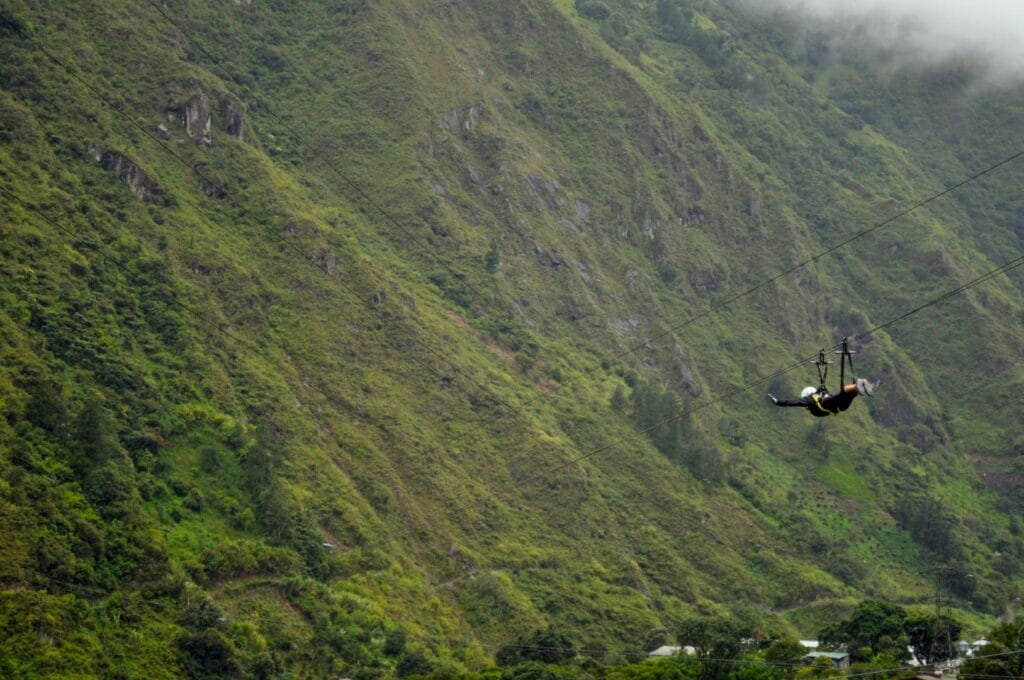
Ruta de las cascadas
Baños is the gateway to the famous waterfall route, the ruta de las cascadas! This road is almost 20 km long in the direction of Puyo, and allows you to see almost 60 waterfalls to the east of the town! Yes, yes, that’s it! But the best-known waterfall (and by far the largest and most impressive) is the Pailón del Diablo, located in Rio Verde. To get as close as possible, you’ll need to walk for half an hour from the parking. There are two paying access points: an upper one and a lower one. To get close to the summit of Pailón del Diablo, you have to follow a series of signposted paths which, let’s be honest, sometimes give the impression of having been built for Lilliputians.
If you take a walk along the ruta de las cascadas, you’re likely to see flying men – by which we mean people with no fear of heights – lying on their stomachs, ziplining 1 km horizontally down the canyon… Alternatively, you can reach the other side in a homemade cable car, the tarabita, which seems safer, in theory… In fact, it’s a clever combination of a truck engine and a gondola. You’ll find it at the Agoyan and Manto de la Novia waterfalls. The price is $2 each time.
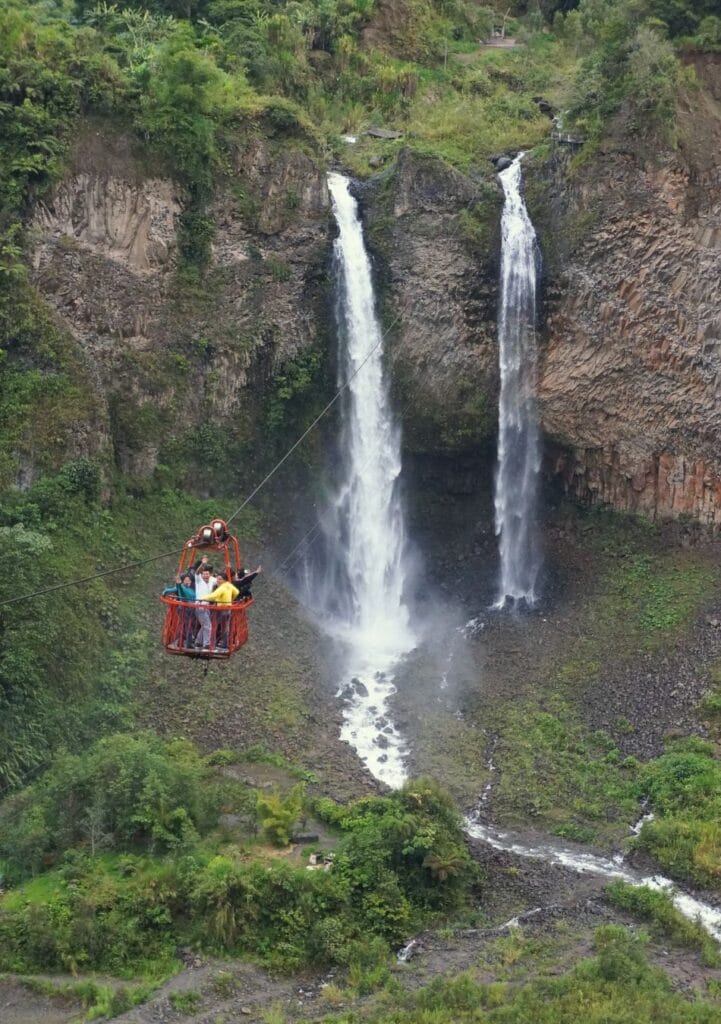
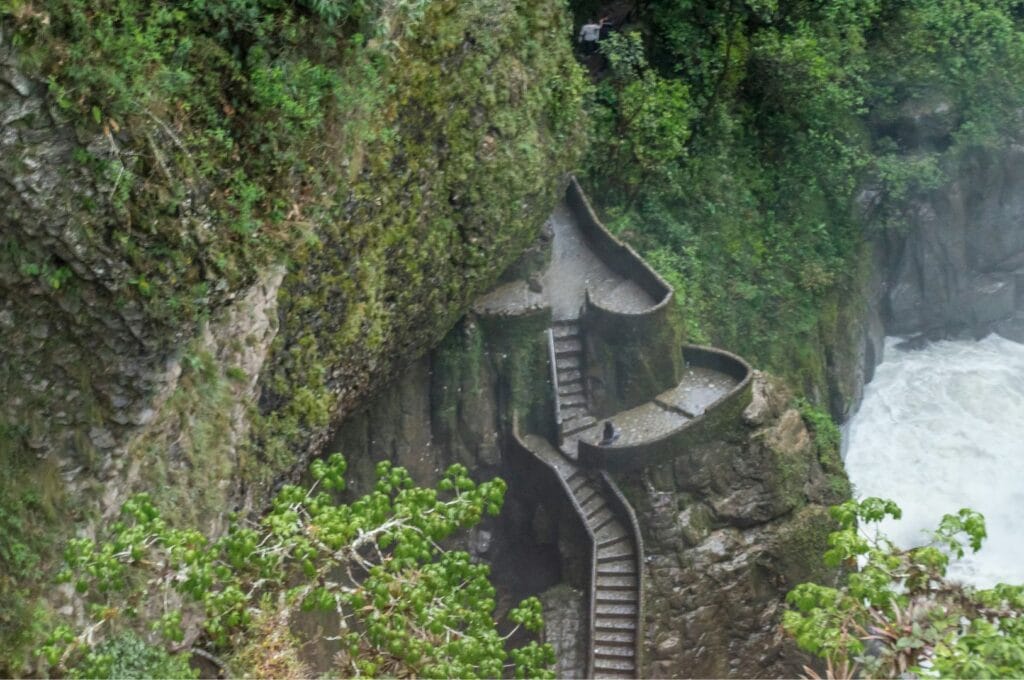
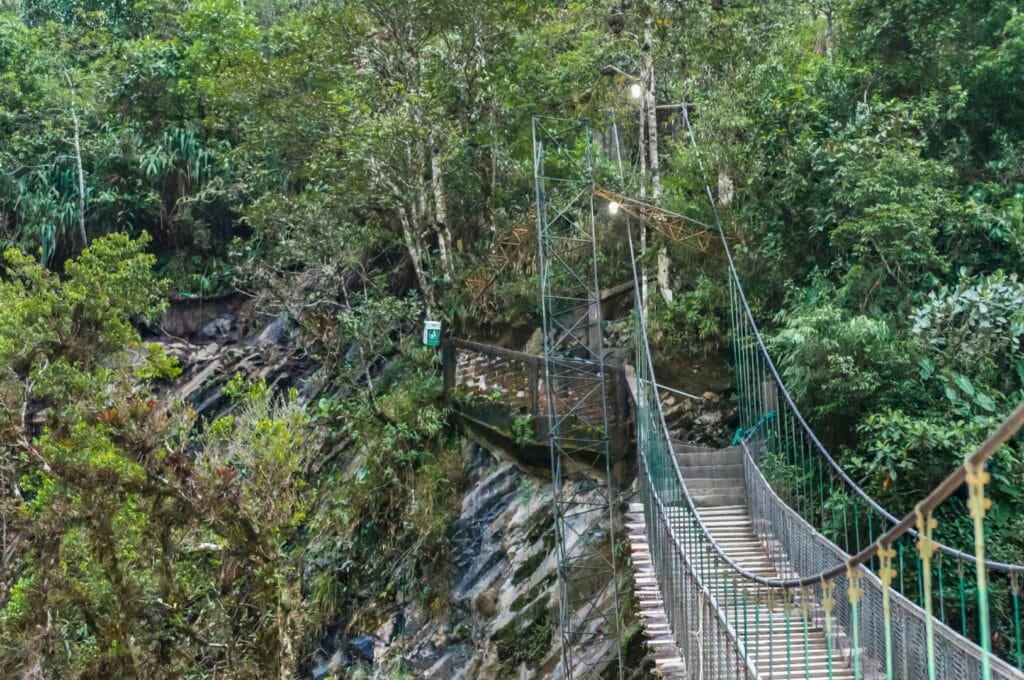
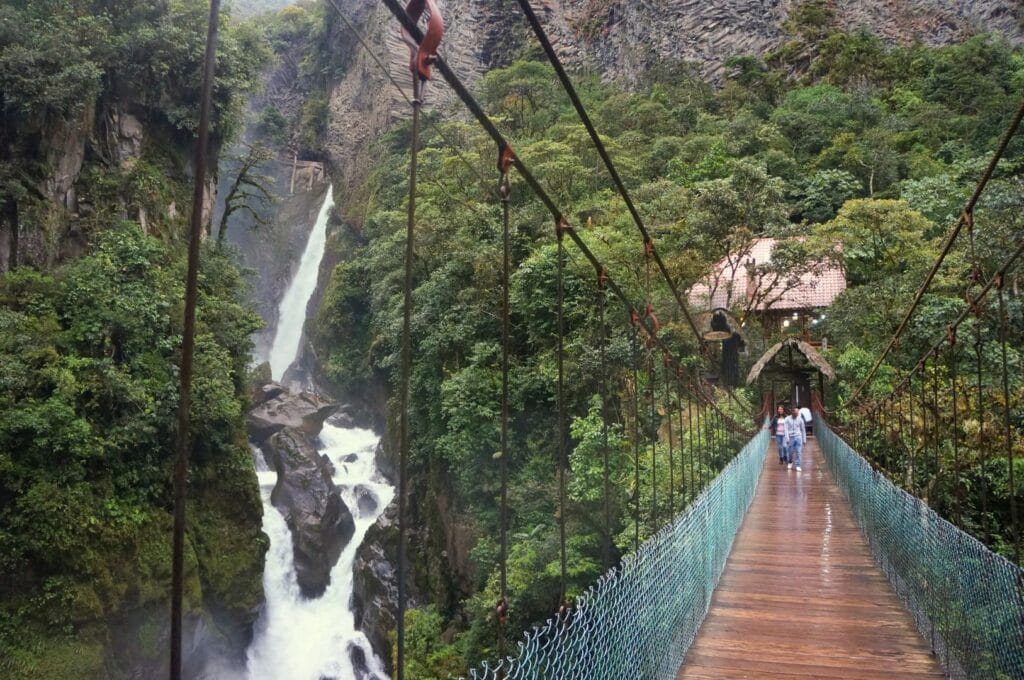
To make the most of the Route of the Cascades, you have three options:
- go on an organized tour and take either a double-decker bus or an old truck refitted as a disco bus more commonly known as a chiva (the price is around $10 per person);
- rent a bike (between 5 and 10 dollars a day) and ride the 20 km leisurely in one direction (it’s downhill most of the time!), then load the bike onto a shuttle bus to return to Baños. It’s also possible to push on to Puyo, where a bus will easily take you back for 1 or 2 dollars;
- take the bus: we didn’t know this was possible, but you can take the bus from the Baños terminal and ask for the first stop on the route to the waterfalls. Once your visit is over, you wait a few minutes at the bus stop before taking one to the next stop. This will cost you around $1 maximum per person per stop.
If you know us a bit, you’ll have guessed that we’d have opted for mountain biking. But we were out and about with a whole group from our Spanish school, and the program wasn’t very flexible. In short, it was in a chiva, a magnificent multicolored bus, with the sound system cranked up and a stripper pole to boot, that we set off on the route.
For us, this waterfalls tour was a bit of a flop… The atmosphere was certainly very nice, but frankly, the option of a bus that stops for 3 seconds to take a photo and then leaves with the music was a bit too much for us. That’s why we recommend a bike or bus instead!
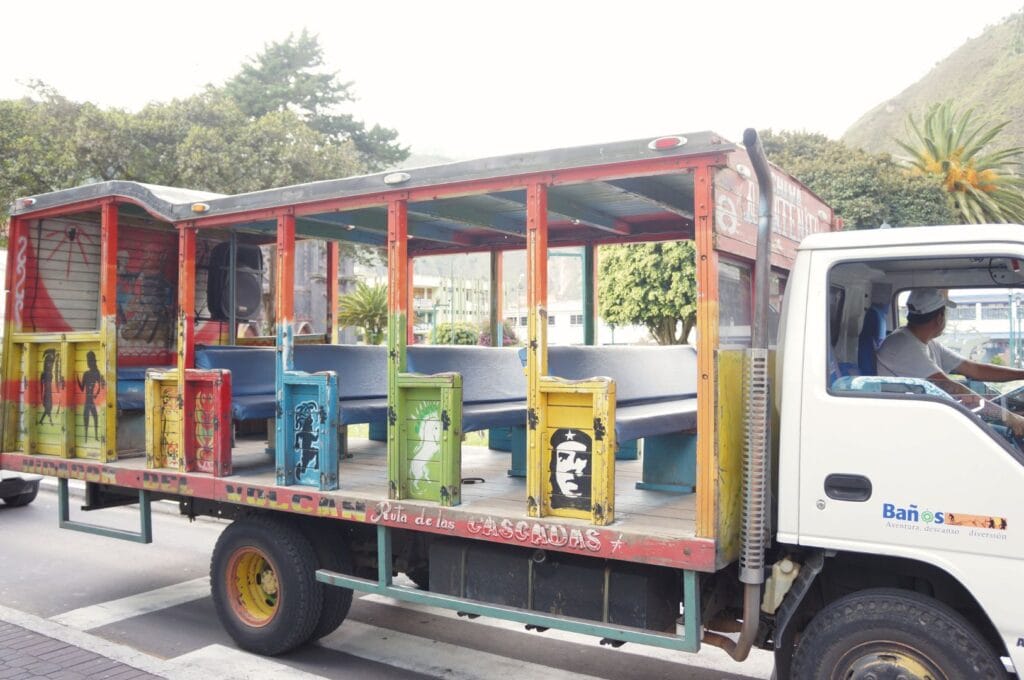
The melcocha
While visiting Baños, we finally discovered how the melcocha that is found all over Ecuador is produced. In a way, the town is the capital of these delicacies! But what is melcocha? Melcocha is a form of candy, often sold in stick form, made from boiled sugar cane. Where it gets interesting is that, after cooking, the dough has to be stretched and kneaded for many hours before it hardens into a candy.
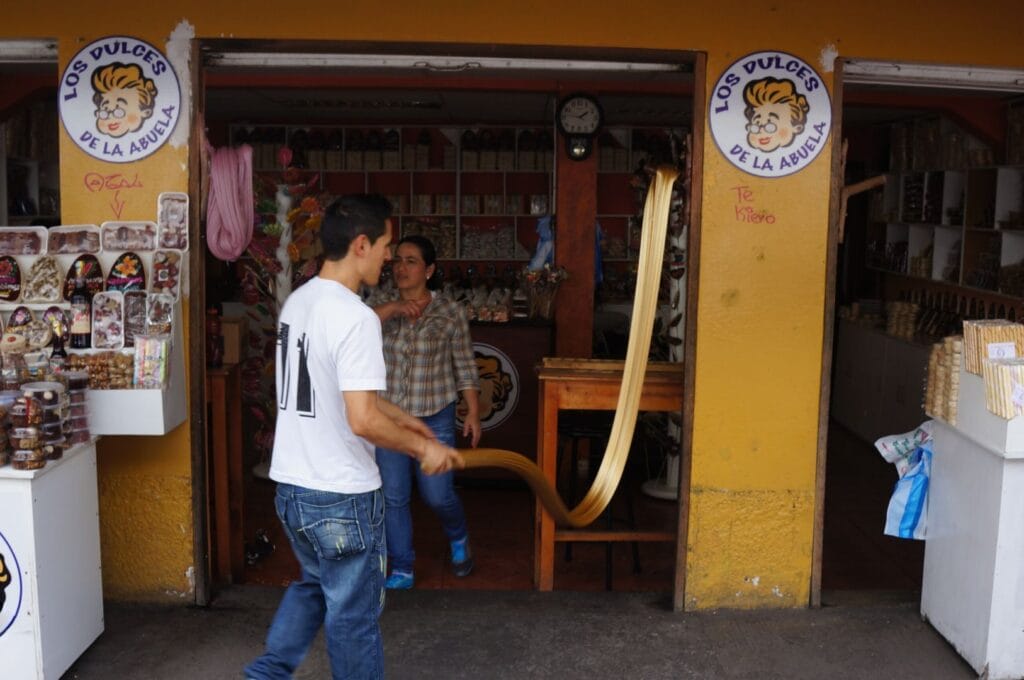
So it’s only logical to see these large strips of dough hanging from doorsteps and handled with bare hands by Ecuadorian vendors all over Baños. It’s probably not the most regulatory thing according to European health standards, but I’d like to tell you that after Asia, nothing shocks us in this respect! And what’s more, when it’s good, we forget everything else, don’t we? 😉
Another Baños gastronomic specialty is cuy, otherwise known as roasted guinea pig! Sorry, we sit this meal out… Will you try it for us?
Baños hot springs
On the second day, our group set off for the famous Casa del Arbol. But as the weather wasn’t cooperating and we wanted to do a bit of walking (and not be driven from point A to point B in a minibus), we decided to go our own way and headed for the thermal baths, whose water is heated naturally by the Tungurahua volcano!
As a small spa town, Baños boasts numerous spas and 6 public thermal baths, the best-known of which are the Termas de la Virgen (Baths of the Virgin), in the center of town. However, the nearest thermal baths to the center of town are the most crowded, so we opted for the Balneario El Salado thermal baths, located roughly 3 km from Baños.
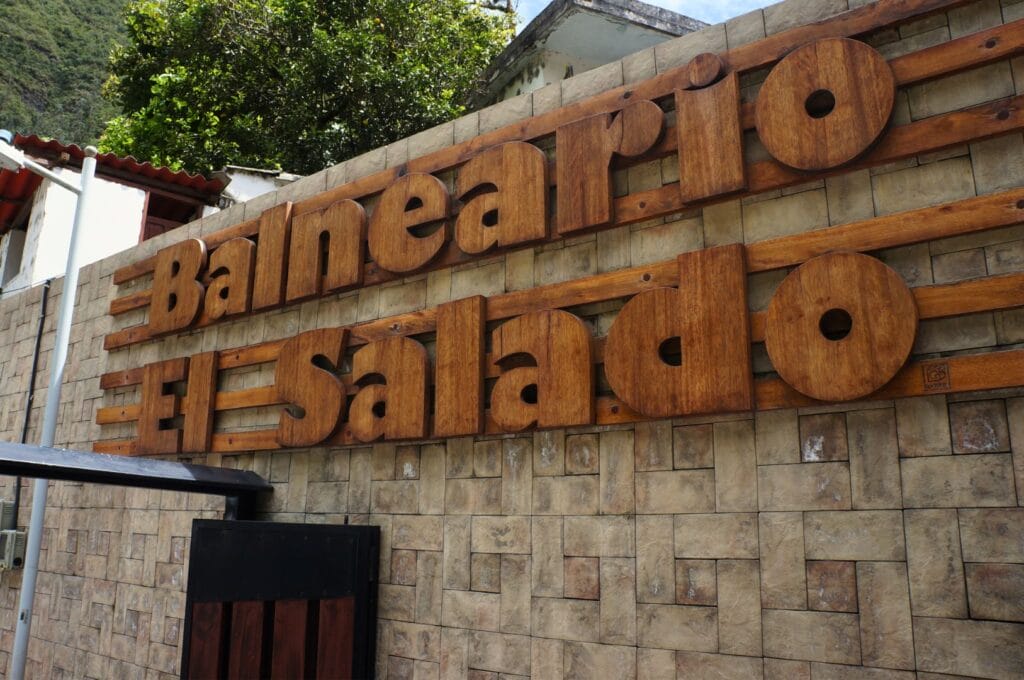
Balneario El Salado
In this case, I was a little naive. I was expecting to find a lovely oasis of calm and relaxation… When we got there, we discovered the 4 raw concrete pools and the happy mix of senior citizens who had come to recharge their batteries. As a bonus, we’ve got kids running around with their muffs and floaties… No other gringos in sight, though! No doubt about it, we’ve arrived at the hot springs recommended by the Ecuadorians! The admission fee to the Balneario El Salado is $4, like all the others.
At the checkout, our Spanish was put to the test for the first time. “Gorro what?”. “What does the lady want from us?”. “Gorro de baño!”. A moment of solitude and intensive reflection, until the kind cashier took pity on us and showed us a bathing cap. Aaaaah! In short, we invested the crazy sum of 50 cents to become the proud owners of our very first 100% plastic, 200% sexy bathing caps! By the way, this magnificent headgear is compulsory in all the city’s thermal baths.
The water in the baths is supposed to be holy (hence the town’s full name, Baños de Agua Santa) and those who bathe there are supposed to experience good luck and happiness! So, with all our travels still ahead of us in South America, we played the long game and spent around 1 h 30 soaking in the 42°C thermal water!
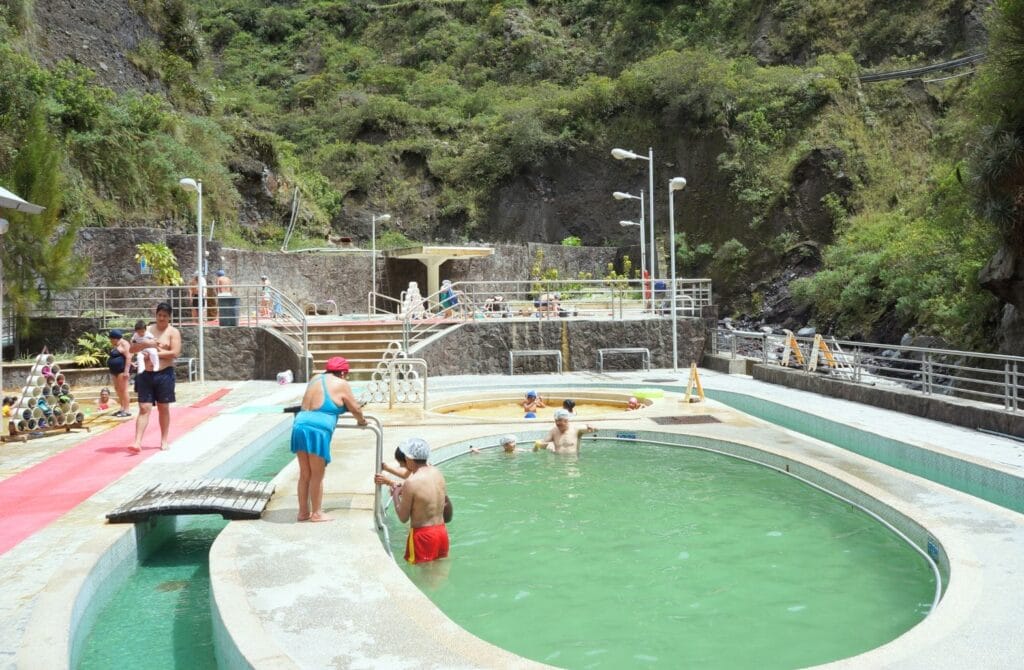
Other hot springs in Baños
In addition to the Thermal Baths of the Virgin and the Balneario El Salado, there are other public baths in Baños: Termas de Santa Ana (not very recommendable due to the dilapidated state of the premises) and Balneario Santa Clara (a pool with a slightly cooler temperature and warmer pools with a sauna). For the rest, there are numerous spas, the most famous being El Refugio Spa Garden.
Mirador de la Virgen
Once invigorated after the hot springs, we (well, Ben) hadn’t yet had our fill of walking for the day. So we set off for the monument to the Virgin, which overlooks the town of Baños, still limber from the thermal baths. The trailhead is located just behind the municipal cemetery, to the south of town, at the end of Misioneros Domincanos Street.
I’m not going to lie to you, I had to suffer to get to the top! Admittedly, it’s not very high and the stairs are much shorter than those leading to Mount Emei in China, but go figure, between the mountain air, and the post-spa effect, all combined with an acute attack of laziness… To give you an idea, you’re only doing 650 meters but you’re taking on 160 meters of positive ascent! But no matter how much I grumbled, I reached the top! Luckily, the weather even opened up a little, and we were able to enjoy a lovely view of the city.
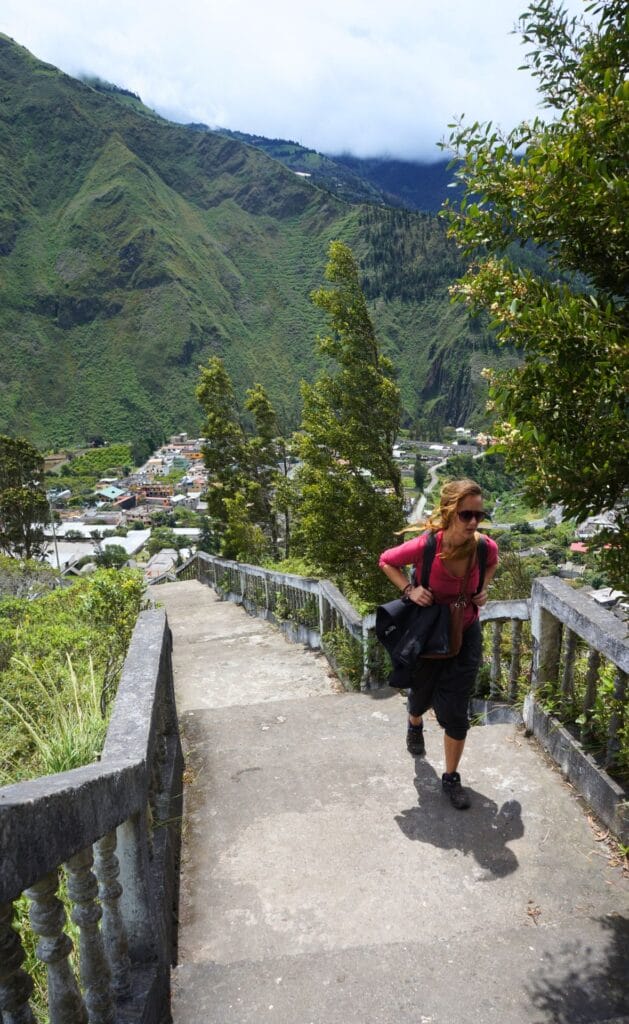
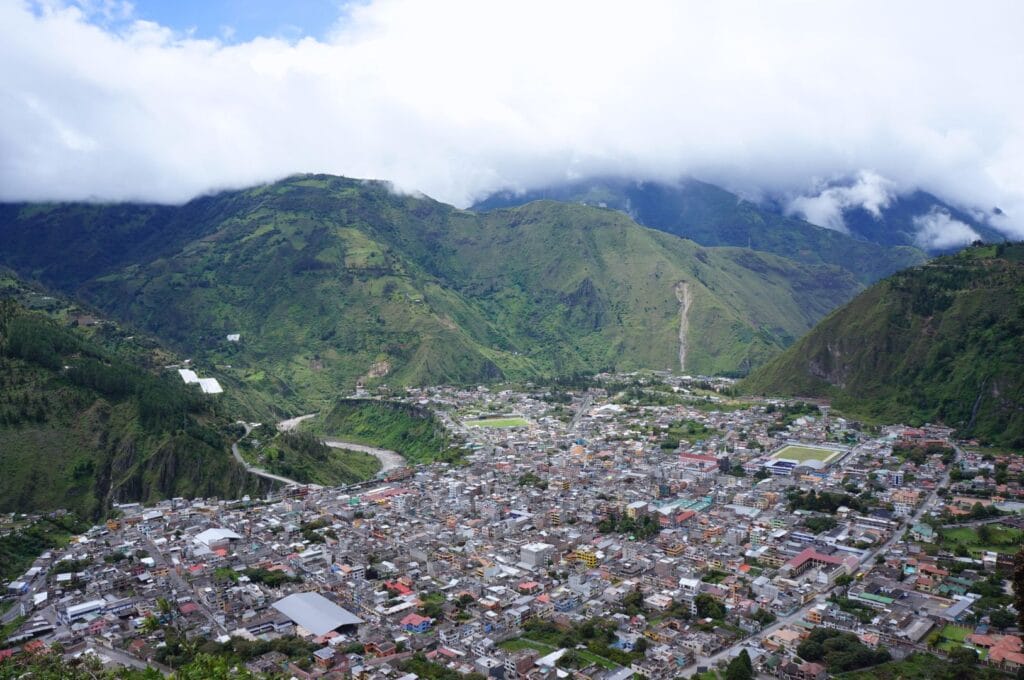
The Casa del Arbol and its most famous swing
Perhaps you’ve already seen the mythical photo of this swing in the clouds, without even knowing that it’s in Ecuador (as in Bali, the land of Instagrammable swings)? For good measure, we came to Baños but didn’t go to Casa del Arbol, for the simple reason that the vagaries of the weather meant that the view was simply non-existent. Fog, rain and clouds decided to invite themselves to the party… So it was impossible to see the Tungurahua, which is just around the corner in good weather!
You can get to Casa del Arbol by bus for $1 (meet at the intersection of Vicente Rocafuerte and Pastaza streets), and admission costs $1 per person. Tip: to get back down, you can hike a 3.1 km trail back to the center of Baños instead of taking the bus.
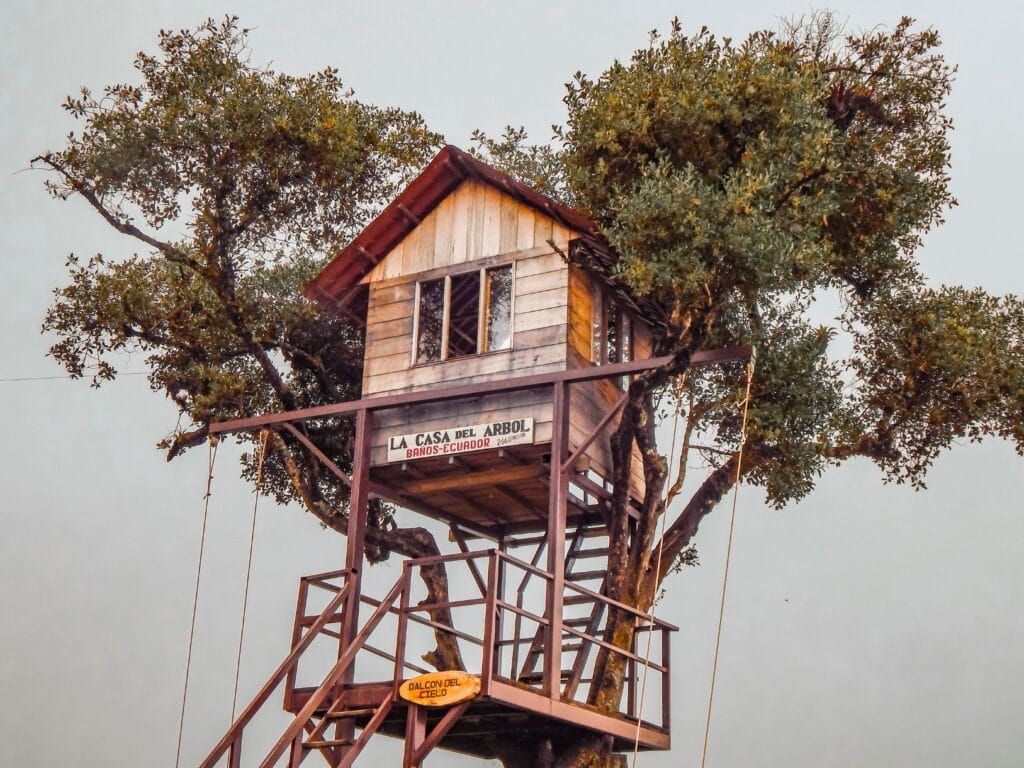
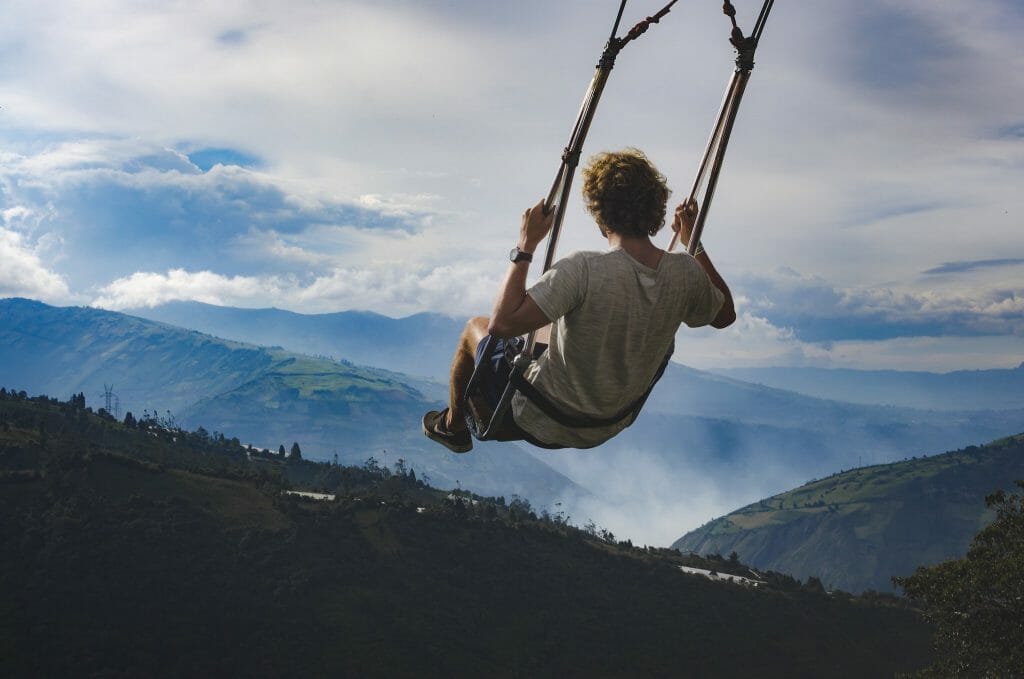
Tungurahua volcano
Located at the northernmost point of Sangay National Park, the Tungurahua volcano is an impressive 5023 meters high! The trail to its summit is demanding: 6 km one way, with a 2065 m vertical drop. You’ve been warned! However, it is entirely possible to climb Tungurahua volcano on your own, without a guide, over 1 or 2 days, depending on your level of fitness. There’s a refuge 2 km from the summit if you’d like to spend the night ($15 per person).
To find out whether conditions are excellent, check with the locals or the GVP website for the latest volcano activities, and the mountain-forecast website for the weather at the summit. Here’s the trek profile, you can download the trail here.
To plan your ascent, we recommend Emma’s account.
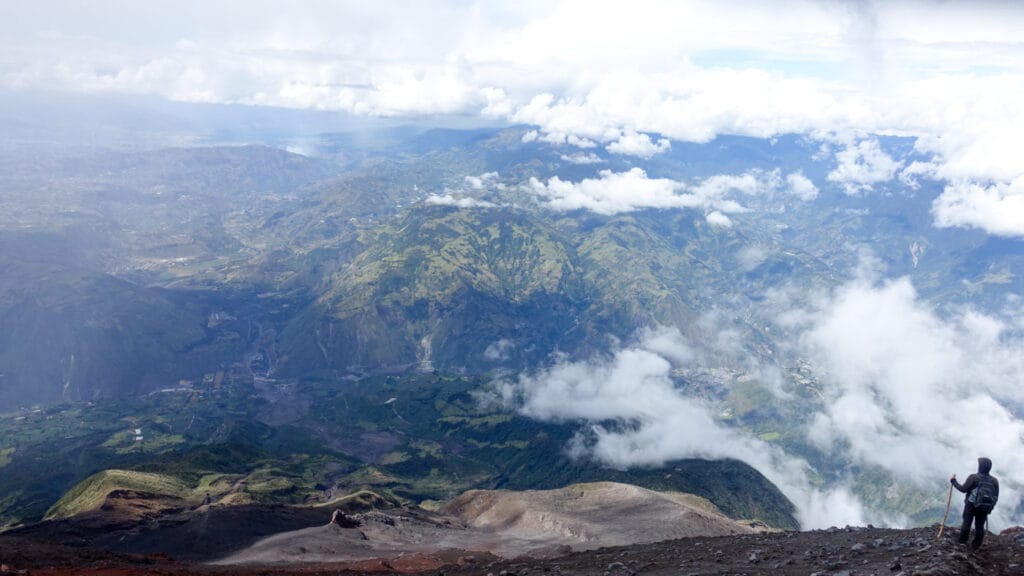
Tips and review of our 2 days in Baños
Ouch… I feel like we’re going to sound like an old couple. But this organized group weekend was so-so. Sure, we enjoyed each other’s company and had a great time. But I think that after 10 months of just the two of us doing things exactly the way we wanted to, we may no longer be the best customers for group tours…
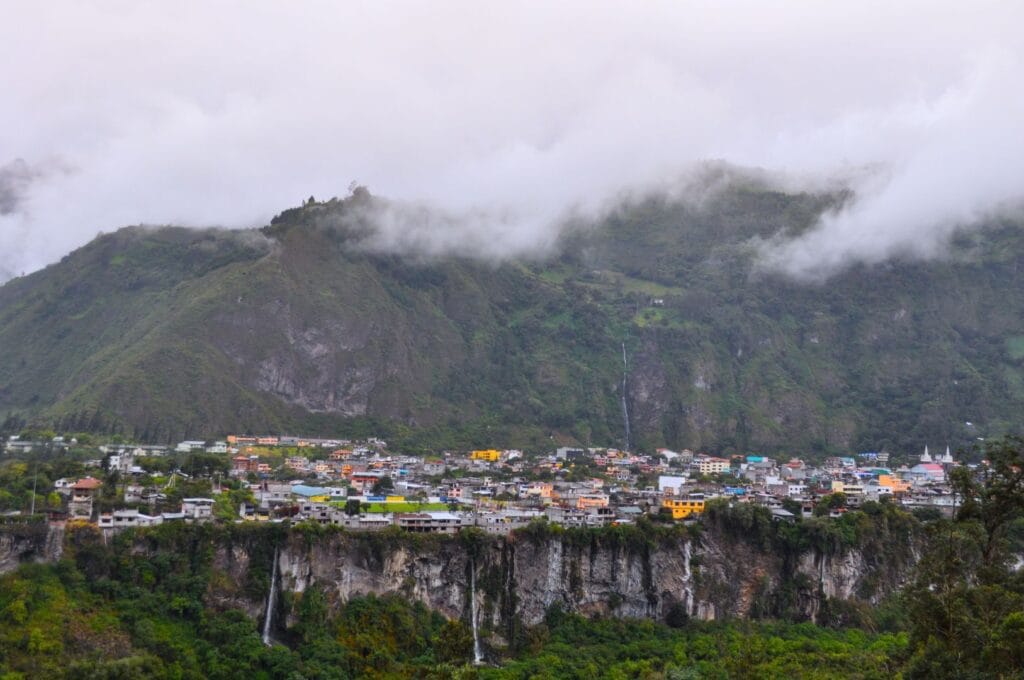
Tips for visiting Baños in Ecuador
In the end, we’d change several things if we had to do it all over again:
- we’d stay longer in Baños: 2 days and 1 night is definitely too short to discover everything;
- we’d opt for weekdays rather than weekends, to avoid the Ecuadorians coming to recharge their batteries;
- we’d probably have done the waterfalls route on our own, i.e. by bike or bus;
- we’d probably have taken more care to check the weather forecast. If the weather had been fine, we’d probably have gone for a longer walk in the direction of the Tungurahua volcano and tested the world’s most vertiginous swing…
- and with a bit of luck, we’d have been able to watch the lava flowing out of the volcano at night! This activity is only possible when the volcano wakes up (but not too much, I assure you), but unfortunately during our visit, there was no lava on the horizon.
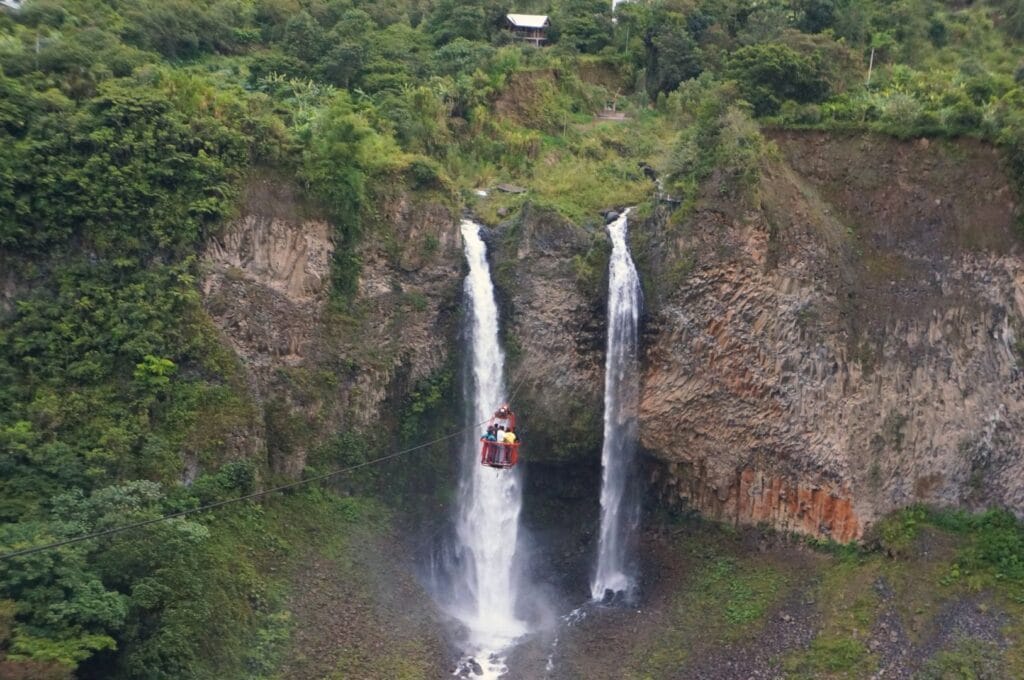
Review of our 2 days
Finally, despite the catastrophic weather during our stay, we really enjoyed the Baños region. So much so, that we returned to this little corner of paradise one more time! Well, once again we weren’t spoiled by the weather, but we’ll keep only the positive. The landscapes are truly MAGNIFICENT, but a weekend isn’t enough to fully enjoy the region! Next step in our series of articles on Ecuador: our complete guide to the city of Quito! Are you coming?
Pin it
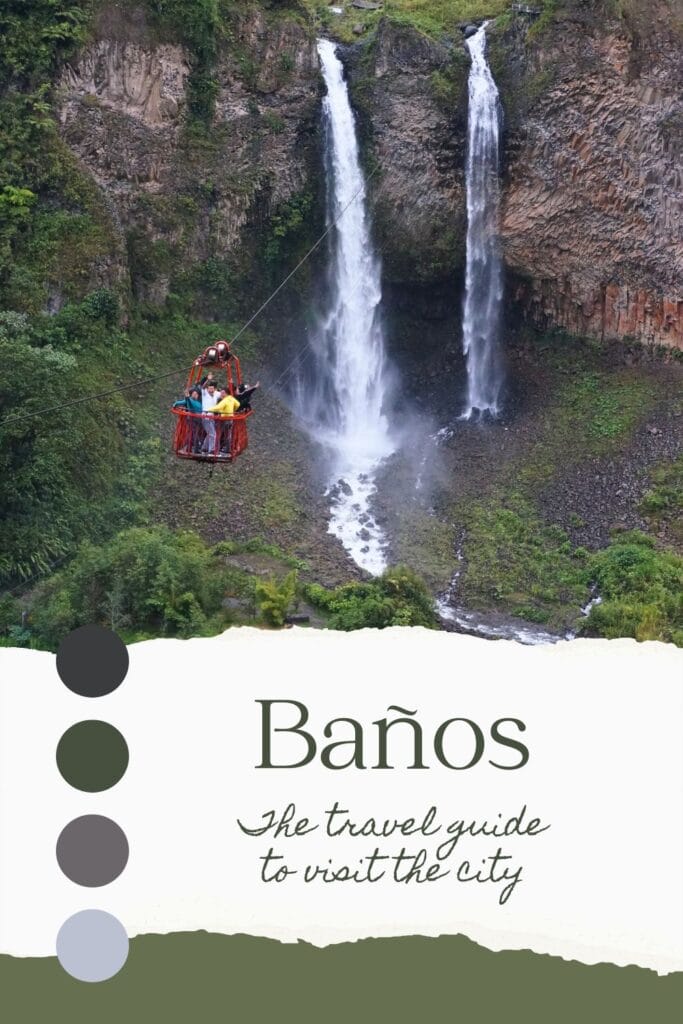
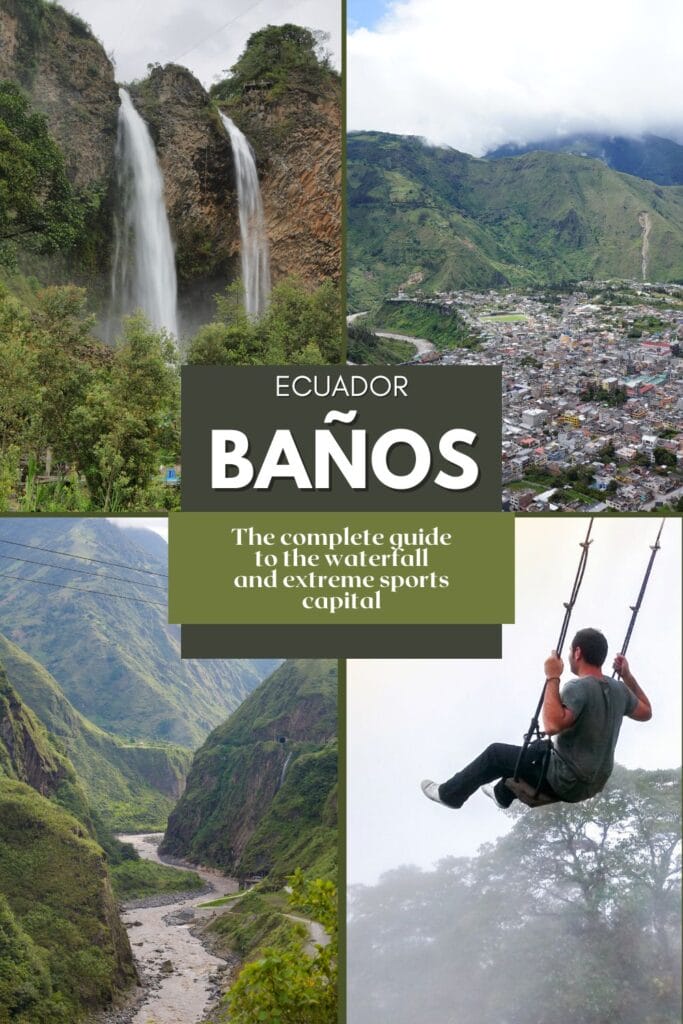
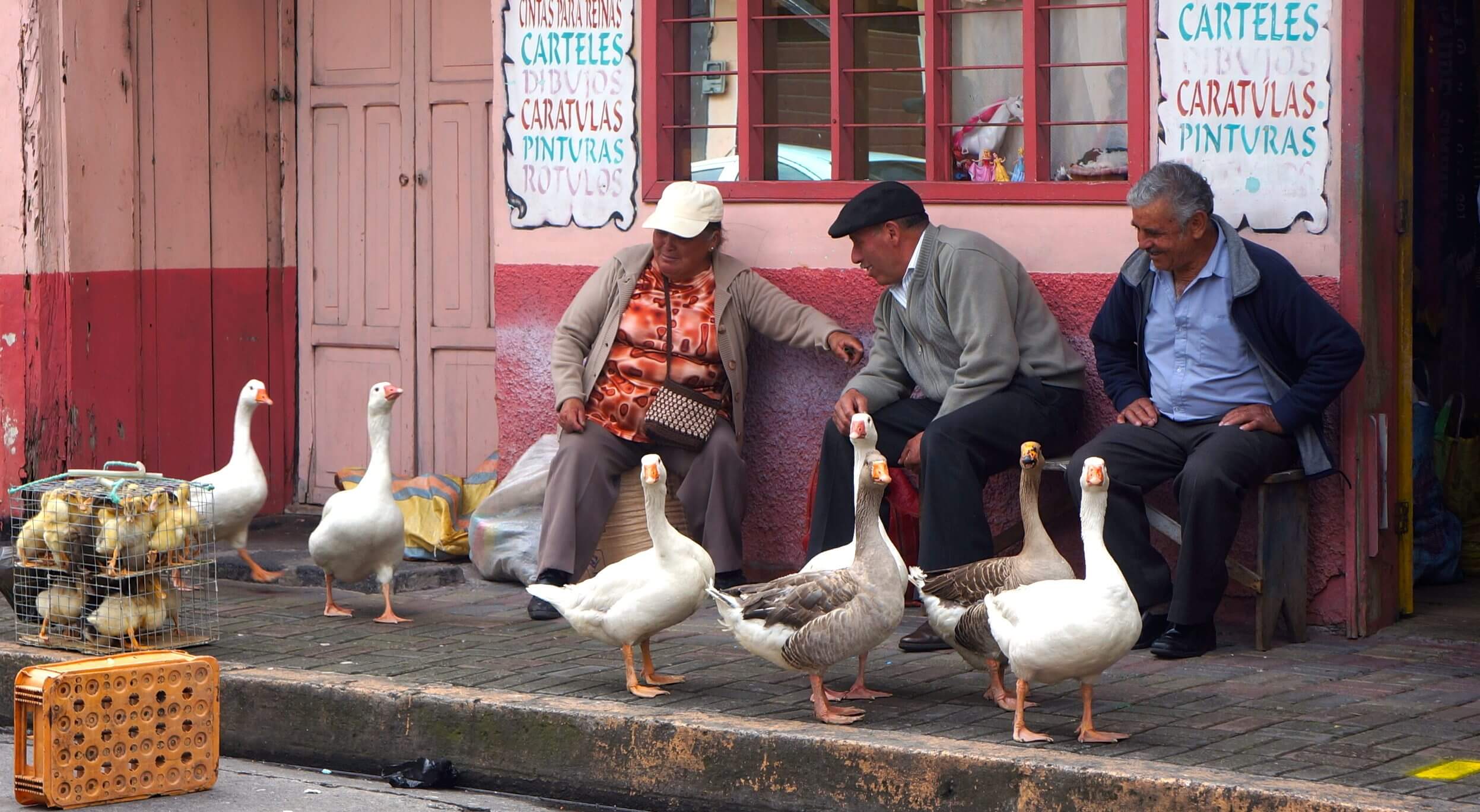
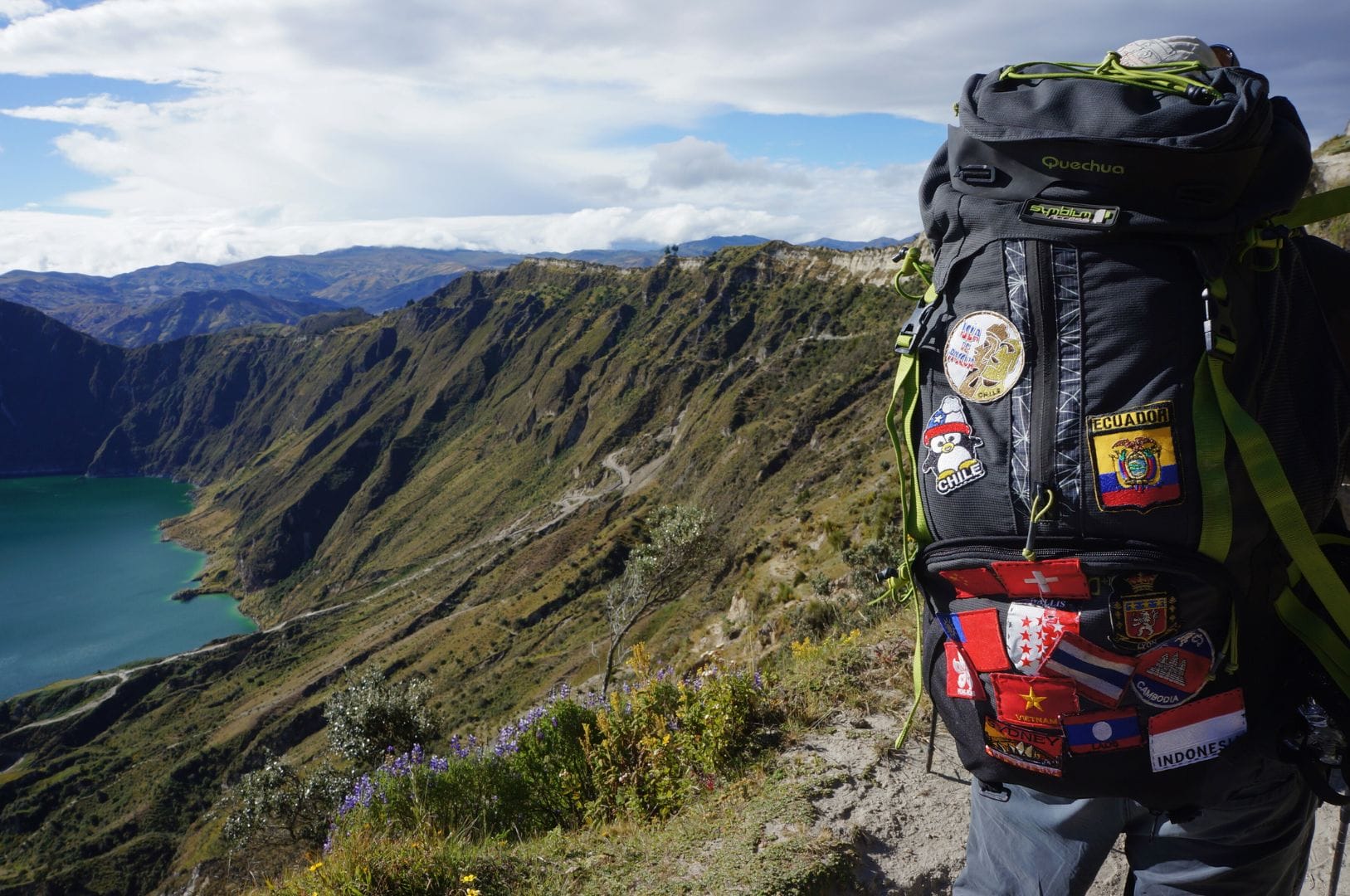
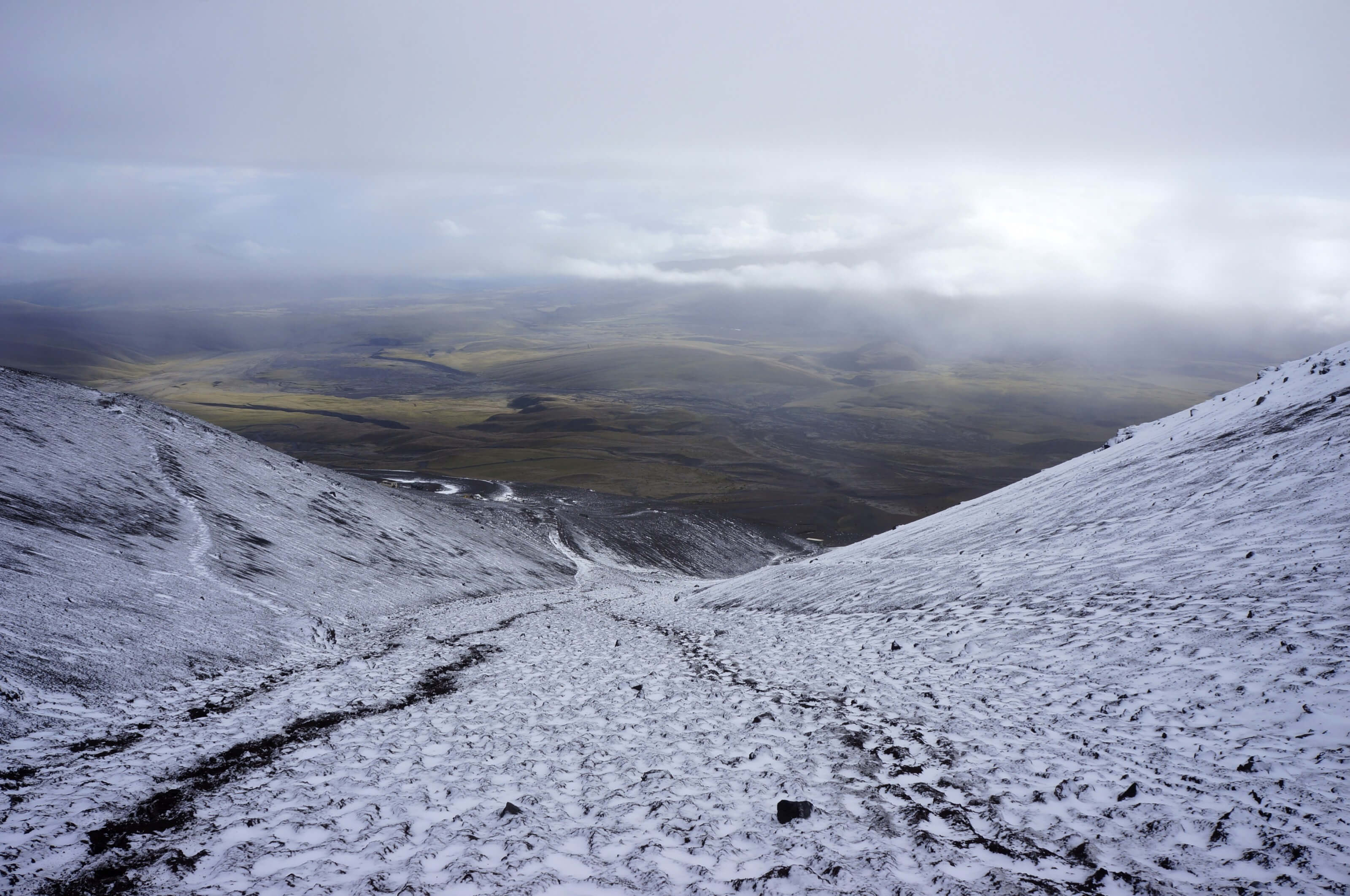
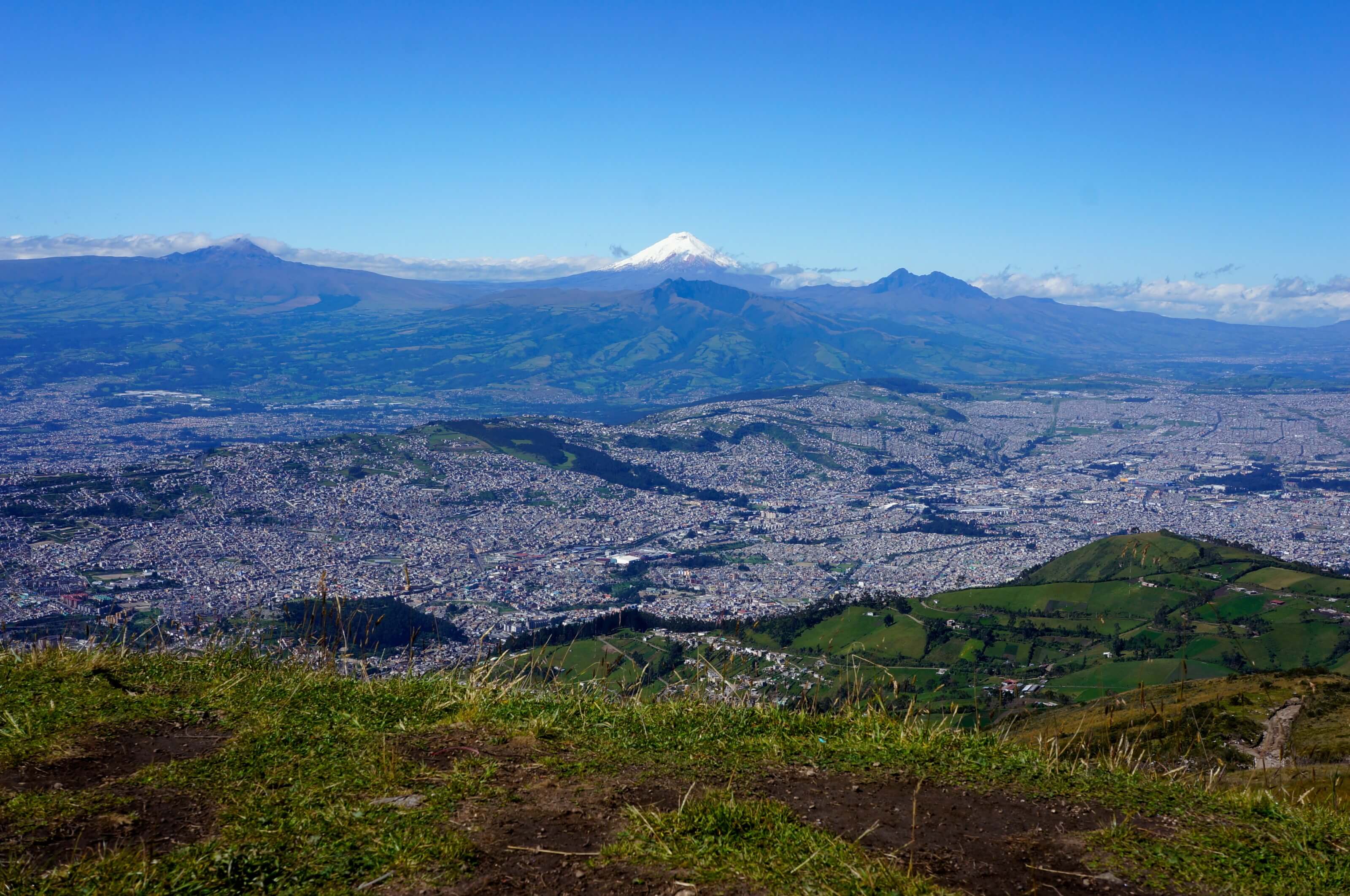
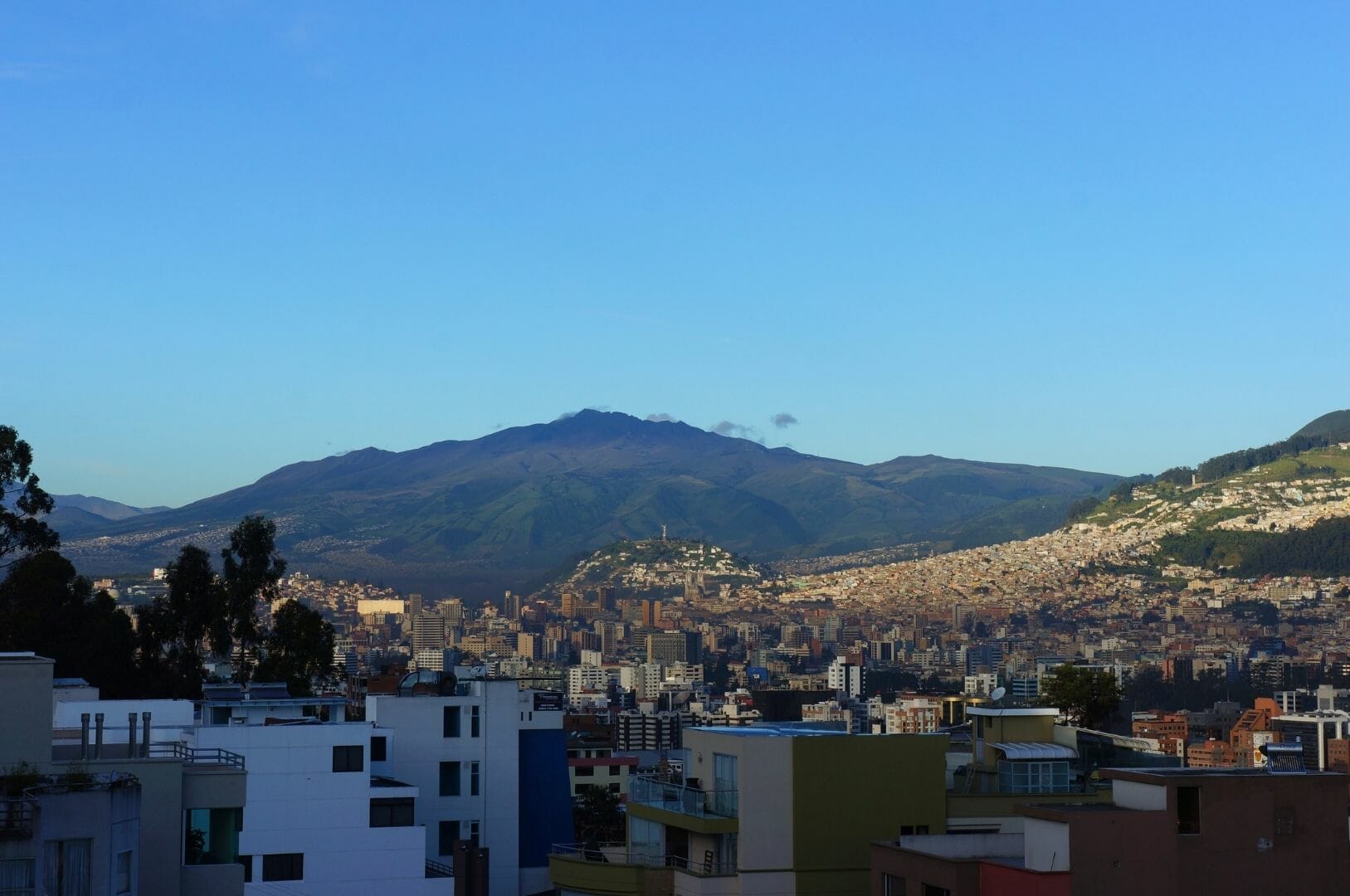
Join the discussion